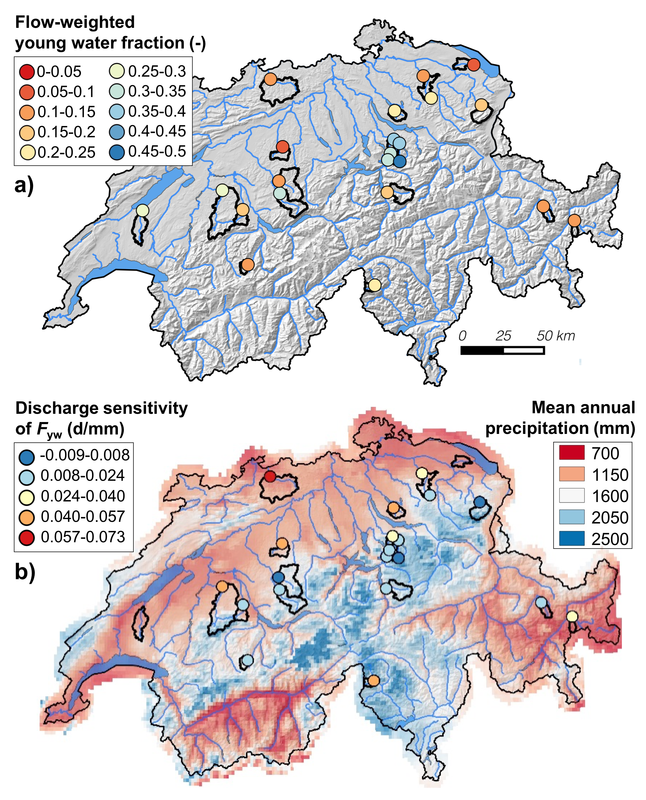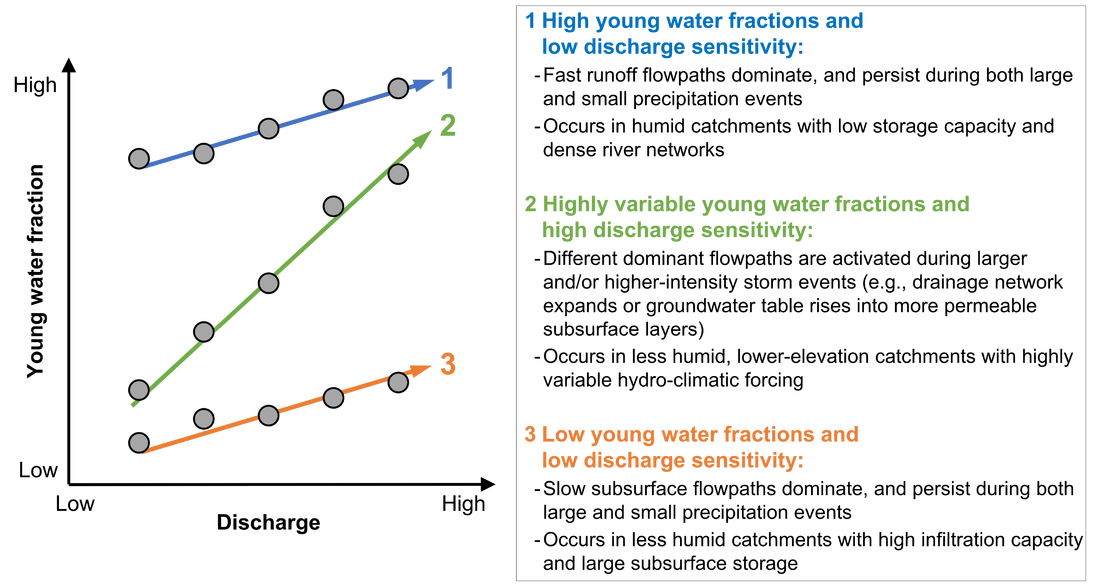Young-water fractions in Swiss catchments
The young water fraction Fyw, defined as the proportion of catchment outflow younger than approximately 2-3 months, can be estimated directly from the amplitudes of seasonal cycles of stable water isotopes in precipitation and streamflow. Thus, Fyw may be a useful metric in catchment inter-comparison studies that investigate landscape and hydro-climatic controls on streamflow generation. Here, we explore how Fyw varies with catchment characteristics and climatic forcing, using an extensive isotope data set from 22 small- to medium-sized (0.7 - 351.2 km2) Swiss catchments.
|
We find that flow-weighting the tracer concentrations in streamwater resulted in roughly 26 % larger young water fractions compared to the corresponding unweighted values, reflecting the fact that young water fractions tend to be larger when catchments are wet and discharge is correspondingly higher. However, flow-weighted and unweighted young water fractions are strongly correlated with each other among the catchments. They also correlate with terrain, soil and land use parameters, as well as with mean precipitation and measures of hydrologic response.
Within individual catchments, young water fractions increase with discharge, indicating an increase in the proportional contribution of faster flowpaths at higher flows. We present a new method to estimate the linear slope of this relationship between flow and young water fractions, which we call the discharge sensitivity of Fyw. Among the 22 catchments, discharge sensitivities of Fyw are highly variable and only weakly correlated with Fyw itself, implying that these two measures reflect catchment behaviour differently. |
Based on strong correlations between the discharge sensitivity of Fyw and several catchment characteristics, we suggest that low discharge sensitivities imply greater persistence in the proportions of fast and slow runoff flowpaths as catchment wetness changes. High discharge sensitivities, on the other hand, imply the activation of different dominant flowpaths during precipitation events, such as when subsurface water tables rise into more permeable layers and/or the river network expands further into the landscape.
References:
- von Freyberg, J., Allen, S. T., Seeger, S., Weiler, M., and Kirchner, J. W.: Sensitivity of young water fractions to hydro-climatic forcing and landscape properties across 22 Swiss catchments, Hydrol. Earth Syst. Sci., 2017, 1-34, 10.5194/hess-2017-720, 2017.
- Kirchner JW (2016a) Aggregation in environmental systems-Part 1: Seasonal tracer cycles quantify young water fractions, but not mean transit times, in spatially heterogeneous catchments. Hydrol Earth Syst Sci.;20(1):279-97.
- Kirchner JW (2016b) Aggregation in environmental systems-Part 2: Catchment mean transit times and young water fractions under hydrologic nonstationarity. Hydrol Earth Syst Sci.;20(1):299-328.
- Seeger S, Weiler M. (2014) Reevaluation of transit time distributions, mean transit times and their relation to catchment topography. Hydrol Earth Syst Sci.;18(12):4751-71.


